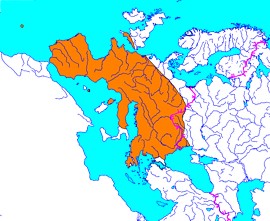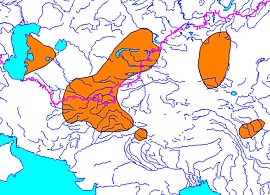|
 SCIENTIFIC
NAME: Plecotus austriacus Fischer, 1829 s. lato SCIENTIFIC
NAME: Plecotus austriacus Fischer, 1829 s. lato
COMMON NAMES: Grey long-eared bat
SYNONYMS: aegyptius Fischer, 1829; kirschbaumi Koch,
1860 = brevipes Koch, 1863; 1878; ariel Thomas, 1911;
wardi Thomas, 1911; kozlovi Bobrinskii, 1926; mordax
Thomas, 1926; meridionalis Martino, 1940; turkmenicus
Strelkov, 1988 pro 1983 nom. nud.; hispanicus Bauer, 1957;
strelkovi Spitzenberger, 2006.
DIMENSIONS: Body mass 6.5-15 g, head and body length 41-58 mm, tail
length 37-55 mm, forearm length 37-47 mm, wingspan 25-30 cm.
DESCRIPTION: Inflations behind nostrils usually poorly developed.
Tubercules covered with vibrissae overe ayes are small, diametre
of each less than 1/3 of width between them. Fur is thick, long,
usually without yellowish and brown tinges. Dorsal coloration varies
from dark grey to greyish- or brownish-white; ventral part is greyish-
or pure-white. Animals fromarid regions have more pale coloration
(up to almost white). Thumb nail is very short and poorly curved.
Auditory bullae are distinctly more inflated than in brown long-eared
bat. Sagittal crest on skull usually well notisable.
Grey long-eared bat itself (s. str.) differs by grey back pelage
contrasting with very pale ventral side, and relatively large skull
and teeth size (upper tooth row exceed 5.6 mm).
 This
species complex includes many geographic forms, which taxonomic
ranck is intensively reviewing now. So, the form kolombatovici
Dulic, 1980 now treated as partial synonim of P. teneriffae,
inhabiting Mediterranean and North Africa; one more species, P.
christei, inhabits the Near East and NW Africa. P. austriacus
s.str in the borders of the former USSR probably occur only
in Moldova and West Ukraine (upper map). Central Asian forms very
probably also represent distinct species, namely P. turkmenicus,
P. strelkovi, P. wardi and P. kozlovi (lower
map), which are, moreover, seem to be closely related to P. auritus,
not to P. austriacus. This
species complex includes many geographic forms, which taxonomic
ranck is intensively reviewing now. So, the form kolombatovici
Dulic, 1980 now treated as partial synonim of P. teneriffae,
inhabiting Mediterranean and North Africa; one more species, P.
christei, inhabits the Near East and NW Africa. P. austriacus
s.str in the borders of the former USSR probably occur only
in Moldova and West Ukraine (upper map). Central Asian forms very
probably also represent distinct species, namely P. turkmenicus,
P. strelkovi, P. wardi and P. kozlovi (lower
map), which are, moreover, seem to be closely related to P. auritus,
not to P. austriacus.
DISTRIBUTION: For the whole complex: Western, Central and Southern
Europe, North Africa, Middle East, Central Asia, Mongolia, China,
western Hymalayas. Distribution of P. austriacus s. str.
is restricted to Western and Central Europe.
NATURAL HISTORY: Usually inhabit open areas: stepp-like or desert
formations, also antropogenous landscapes; occur in mountais ip
to 3600 m ASL. Roosts in caves, mines, different buildings. Emerge
in late dusk. Forage over open places, aroun lone trees, along walls,
green hadges and so on. Feed on different insects which can capture
both in the air or on surface of substrate. Flight is high maneuverable,
sometimes fluttering. Echolocation calls are of low or very low
intensity, with maximum energy at around 50 kHz. Settled species;
hibernating sites in mines, caves, rock splits and buildings. Mating
after the end of lactation. Give births at spring or in the beginning
of summer. Litter contain only one newborn. Lactation lasts ca.
45 days. Nursing colonies contain up to several dusens or even hundrids
of females, males live separately. Estimated longevity up to 15
years.
STATUS: Widespread and common species. IUCN: "LR: lc".
|






